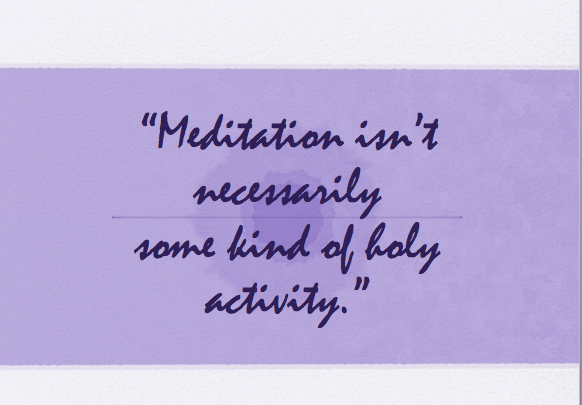Writing and Meditation Brought Down to Earth

I’ve been a bit stuck this morning—trying to think about where to go next with writing and meditation—and so, after staring at the screen for forty minutes or so, thinking in circles and not-writing, I did what I sometimes do when I’m stuck—started looking around at what others think. (Often, I’d be inclined to Google around, but the internet is down here because of a storm and so I had to look around in books!)
I found this paragraph and I appreciated the plain language of it—the sense of space and permission in it—and I feel like it brought me back to earth:
Meditation isn’t necessarily some kind of holy activity; when you meditate you don’t have to imagine holy things up there in the sky. Simply examining your life from the time you were born up till now—looking at the kind of trip you’ve been on and what sort of psychological impulses have been propelling you—is meditation. Observing your mind is much more interesting than watching TV. Once you’ve seen your mind, you’ll find television boring. Checking in detail what you’ve been doing from the time you were born—not so much your physical actions but the psychological impulses driving you to do them—is extremely interesting and is how to become familiar with the way your internal world functions.
The paragraph appears in a book, The Peaceful Stillness of the Silent Mind, by Lama Yeshe, in a chapter called, “Introduction to Meditation.”
Several years ago now I got my first iPod and was looking around on iTunes for free material. I was becoming more interested in Buddhism, and I began looking for lectures on Buddhism, tried some out, and started listening to lectures by Robina Courtin, an Australian Buddhist nun who teaches internationally. When I discovered that her teacher was Lama Yeshe, I did a bit of research on him and found that several of his books were available for free. (A pattern can be discerned here—me looking for free resources!) In any case, I got several of his books and, as with Robina Courtin’s teachings, have appreciated the clear, plain, intelligent, and practical language of them.
When I listen to Robina Courtin’s teachings or read books that have been transcribed from Lama Yeshe’s teachings, meditation doesn’t seem too high or far away or inaccessible. I recognize what is being asked for.
When Lama Yeshe says, “Simply examining your life from the time you were born up till now is meditation,” I can wrap my head around that. Examining my life is meditation. Oh.
And I can see how this clearly overlaps with the practice of writing and healing, for instance with the idea of writing about stepping stones which is a writing exercise I first learned about from Ira Progoff—and which I think I’ll post next week.
For me, having meditation brought down to earth like this makes me feel as if meditation is closer to my reach. I feel a bit more open again—I experience less stuck-ness. I can begin to think again about areas of overlap between writing and meditation, what connections are possible between the two, how the process of one might nurture the other, and how exploring this might promote healing.
The Peaceful Stillness of the Silent Mind can be found for free at the Lama Yeshe Wisdom Archive.
More about Lama Yeshe can be found in a tribute to him by a Christian monk, Father P. Bernard de Give, written after Lama Yeshe’s death.
